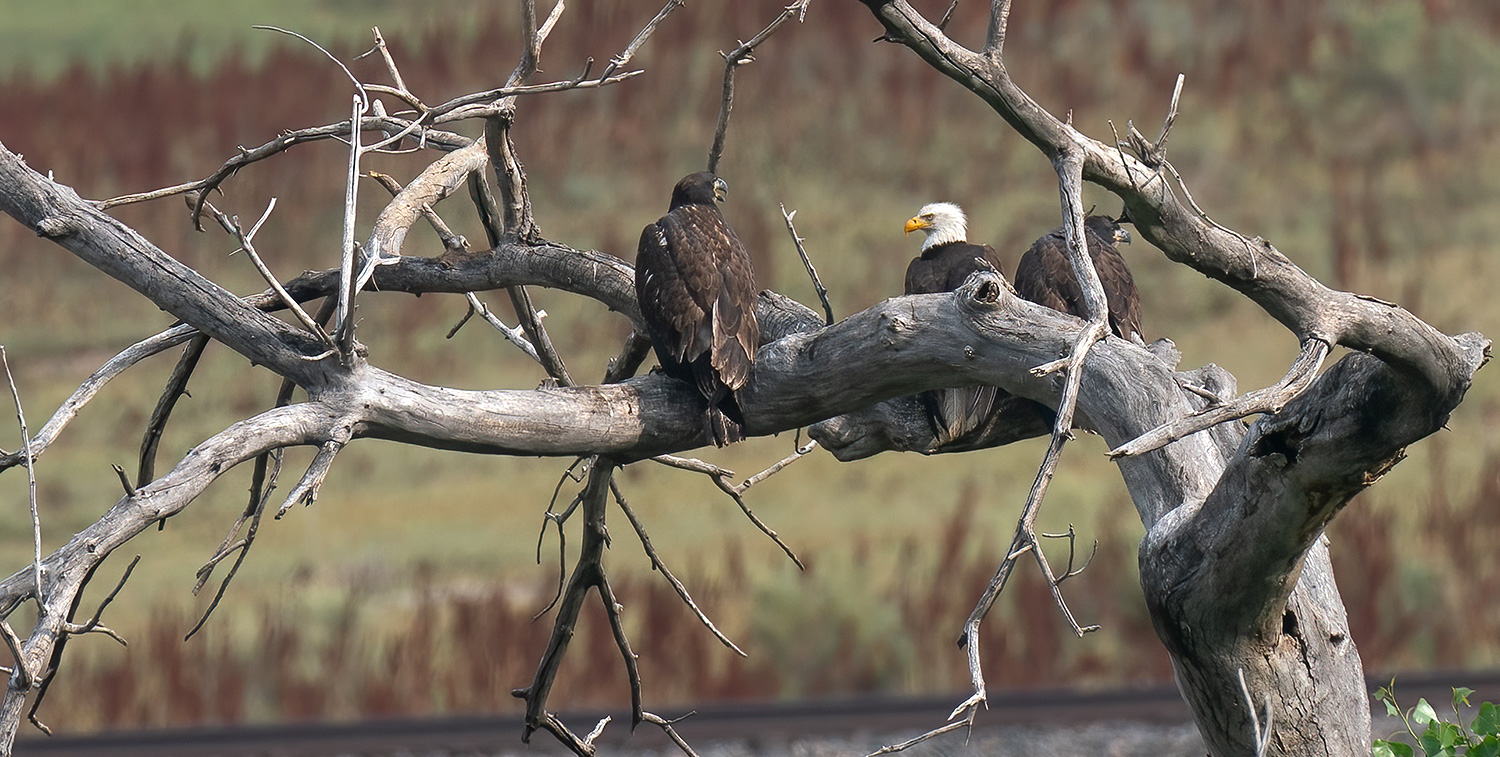Visiting or “Other” Bald Eagles In Occupied Bald Eagle Nest Territories (Northern Front Range)

Stearns adult male in 2021 attending to 2 of his fledgling juveniles.
January 20, 2022
There are often questions that arise when an immature bald eagle is observed in the field or by camera in one of our Front Range nesting bald eagle territories. One of the questions many eagle lovers often have is “could that bird be the offspring of the territorial pair of bald eagles?” While that is often a possibility, especially soon after fledgling juveniles have dispersed from their parents’ territory (a period from fledge to dispersal that can range from 5 to 9 weeks, here), it is very difficult to know if a visiting or “other” bald eagle originated from that nest, or hails from a somewhere else entirely.
The only way to know for sure is from the presence of leg bands, satellite or related tracking devices, or from the presence of easily distinguishable characteristics, perhaps from a recently dispersed juvenile that hasn’t yet gone through first year molt and related feathering changes. In the northern Colorado Front Range, from October into April, there are quite a few non-territorial and/or non-breeding bald eagles that move through our area. Many of these birds spend time in high quality habitat, with prime hunting areas for example, that may overlap with our breeding bald eagle territories.
As a result, Front Range Eagles Studies (FRNBES) records the presence and behavior of “other bald eagles” within our study areas. These “other bald eagles” are mainly comprised of non-territorial bald eagles that are often non-breeders, or migratory breeders that have migrated south during the colder months. The two graphs below describe the maximum count of “other bald eagles” observed at two different nest territories during our study sessions through the course of a year; the dates of those study sessions and associated counts are portrayed along the horizontal axes. The first graph (Figure 1) portrays counts of “other bald eagles” at an “upland” nest in the Broomfield, Colorado area (Stearns nest). Although the Stearns nest is along a minor tributary, we still consider this an “upland” nest. In contrast, the graph in Figure 2 is from a nest territory directly along Boulder Creek, a major waterway in western Weld County . The graph in Figure 2 portrays “other bald eagle” counts from what we call the “CR16.5” nest. The CR16.5 nest is located directly along this major stream corridor and proximal to numerous ponds–often good fishing sources

Figure 1: 2021 FRNBES data showing total study session count of total “other bald eagles” or eagles “other” than the resident or territorial pair. Stearns is a nest along a smaller or secondary tributary in the northern Front Range, with only one pond as a potential fishing source.

Figure 2: 2020 FRNBES data showing total study session count of total “other bald eagles” or eagles “other” than the resident or territorial pair. CR16 is a nest along a major tributary in the northern Front Range, with numerous ponds as potential fishing sources. Boulder Creek is often a major congregation site for migratory bald eagles and other raptors, especially from October into April.
The orange lines on the graphs indicate days that we have conducted observation sessions in the nest area. The blue lines are total counts of “other bald eagles.” The Boulder Creek nest territory experiences much more frequent visitation from “other bald eagles” as well as greater total numbers than the Stearns nest. You may be wondering why this pattern exists.
As you can see in the two graphs, there is a significantly greater number and frequency of “other bald eagles” during fall through winter months in the CR16.5 nest territory, which is directly along a major stream corridor (Figure 2). This area is an important travel route for migrating raptors, and specifically, bald eagles. Migration corridors such as the one along Boulder Creek, provide critical seasonal resources to migratory species, and when ice-free, provide good fishing for bald eagles–a major attractant to this area. As a result, counts of “other bald eagles” are typically much higher and more frequent in territories along creeks with numerous ponds, compared to “upland” nests like Stearns, which are distal to the major stream corridors. What you should also notice, especially from Figure 2 that shows counts at the CR16.5 nest territory, is the seasonality to other bald eagle traffic moving along these travel corridors like Boulder Creek. As is evident in Figure 2, numbers fall off dramatically outside of the winter to fall months. Recording “other bald eagle” observations and behavior is crucial for understanding the significance of different parts of our local ecosystems throughout the year.
